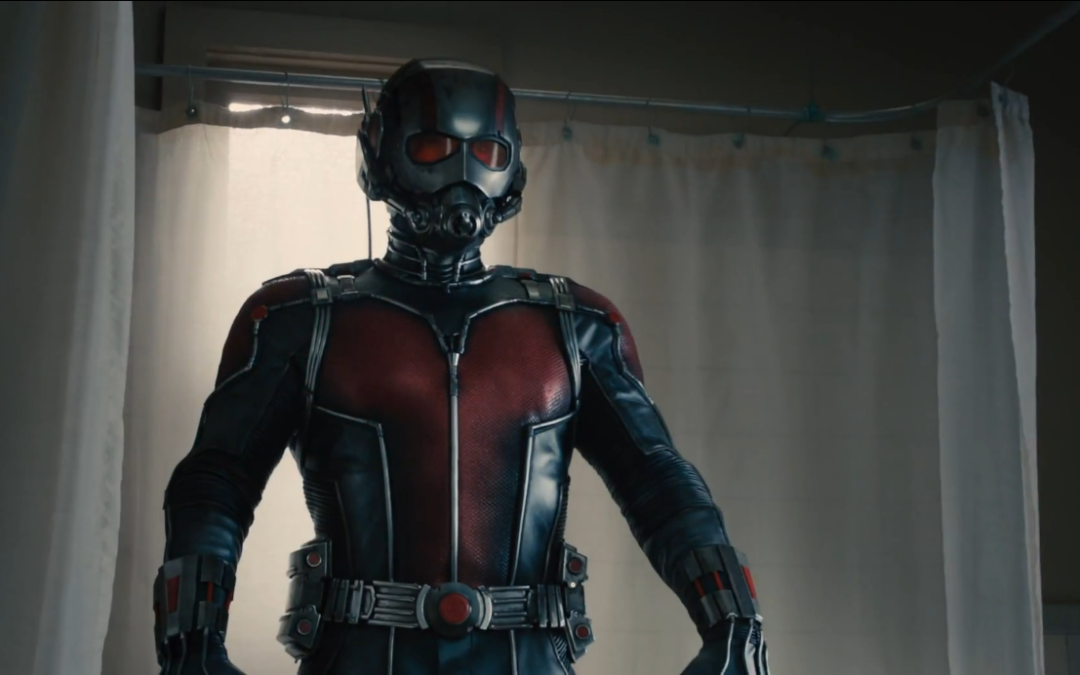Marvel Studios/Superhero Adventure/117 minutes
For those wondering or possibly hoping that Ant-Man was going to be Marvel’s first certified turkey, the Cars 2 of their ingeniously planned and, on the whole, exceedingly well executed Marvel Cinematic Universe, there’s news from the front lines: Ant-Man is just okay. And that’s not a bad thing.
By the end of the last MCU film, Avengers: Age of Ultron, it looked as if the House of Ideas was running out of ones and zeros to launch its latest elephantine, computer-generated blitzkrieg. There was getting to be too many characters and too much plot and too much cold, calculated responsibility to feed the other movies.
Refreshingly, the obstacles overcome by Ant-Man, the movie and the character, are simpler. Cat burglar-gone-straight Scott Lang (Paul Rudd) is enlisted to wear a suit that shrinks him to the size of an ant so he can steal another suit that would shrink bad guys to the size of a wasp. That’s basically it.
The film’s relatively modest ambitions are such a digestif after so many glutinous Phase 2 MCU feasts that its flaws become quaint little personality quirks we’ll gladly ignore so we don’t have to suffer, Clockwork Orange-like, through another CGI bacchanalia.
The screenplay is credited to four writers. One of them is Edgar Wright, the irreverent cult director of Shaun of the Dead. Wright was also slated to helm Ant-Man but was dismissed, reportedly because his standalone vision for the film didn’t mesh with Marvel’s priority of establishing Ant-Man‘s place in the MCU. Wright’s firing sent chills through a fanboy diaspora that was left wondering what might have been, especially when he was replaced by Peyton Reed, director of the perky, cheerleader bauble Bring It On.
As Ant-Man unspools, you may find yourself wondering if the film’s cleverer bits were the work of Wright and fellow original co-writer Joe Cornish. Reed even admitted in a recent interview that Wright and Cornish hatched the film’s best and wackiest idea, having the final battle between Ant-Man and his similarly-sized foe Yellowjacket (Corey Stoll) take place atop a toy train set in a girl’s bedroom.
That girl is Scott’s daughter, Cassie (Abby Ryder Fortson), who’s been estranged from her father since he served three years for one of those “only in the movies” crimes carefully chosen to not alienate the hero from the audience. (Yes, it was illegal, but he did it for noble reasons!) Out of the slammer, Scott is determined to reconnect with Cassie and stay clean, despite the best efforts of his three criminal buddies (lead by a loose and fun Michael Peña, a rare Hispanic face in a Marvel film).
Soon enough, though, Scott is breaking into a formidable-looking mansion where he stumbles upon a black-and-red costume. Mistaking it for a motorcycle outfit, he takes it home, puts it on and accidentally shrinks to insect size. The mansion and the costume belong to research scientist Hank Pym, who is played in wry style by Michael Douglas, his thick and instantly recognizable, honey-toned voice diminished not a whit by the tongue cancer that thankfully failed to fell him in 2010.
Just as Guardians of the Galaxy won over audiences with its irreverence and randy humor, Ant-Man benefits from being a little trippy, with occasional side trips to the absurd. Ant-Man careens down sewers, holds on for dear life on the grooves of a record, navigates footsteps on a dance floor, and gets sucked into a vacuum cleaner. He can also telepathically communicate with ants, instructing hordes of unthinking, easily led insects to carry him around or lift him up, which is about as effective a metaphor for Donald Trump’s presidential candidacy as you’ll find at the summer multiplex.
Ant-Man star and co-screenwriter Paul Rudd is, as usual, an affable light-comedy figure whose layering of modern sarcasm is never so heavy that you can’t image him someday becoming the new Cary Grant. In the ever-expanding pantheon of Marvel heroes, Rudd is the poor man’s Robert Downey Jr., whose casting as Iron Man was so successful it effectively launched the entire MCU.
The one thing Rudd (and Grant) could never effectively convey, however, was sincerity. There’s a dual father/daughter dynamic attempted here, but only Hank and Hope’s end of it, trading on hidden secrets and dreams denied, really has anywhere to go. Scott and Cassie share too little screen time and Rudd can’t maximize the moments they spend together. He always looks a beat away from adding a sassy coda that would deflate any attempt at raw authenticity.
As befitting such an agreeably minor entry in the Marvel canon, Ant-Man tickles and thrills in fits and starts. A mid-point Avenger cameo, which two years and five movies ago, would have been gasp-worthy, can’t compete with the sight of Ant-Man and Yellowjacket fighting inside a briefcase, buffeting around leather-lined innards filled with Lifesaver candies and a mobile phone. Such psychedelic sights help make Ant-Man the right MCU movie for this moment. Most Marvel movies are too much. This one is just enough.

